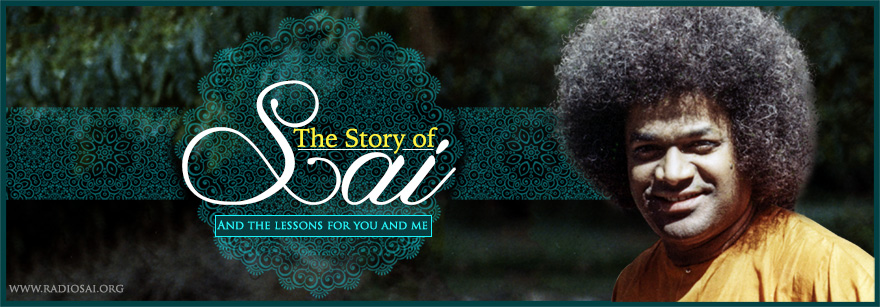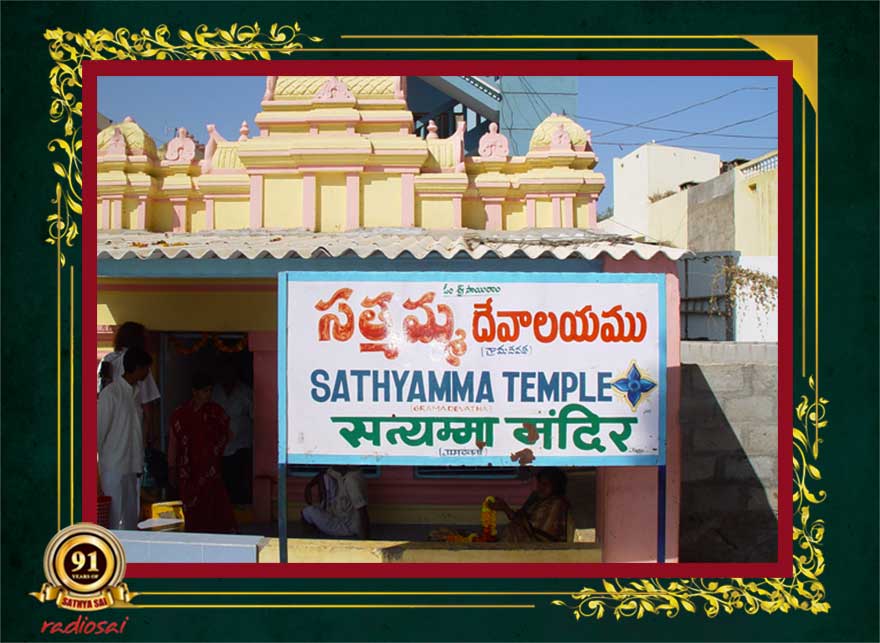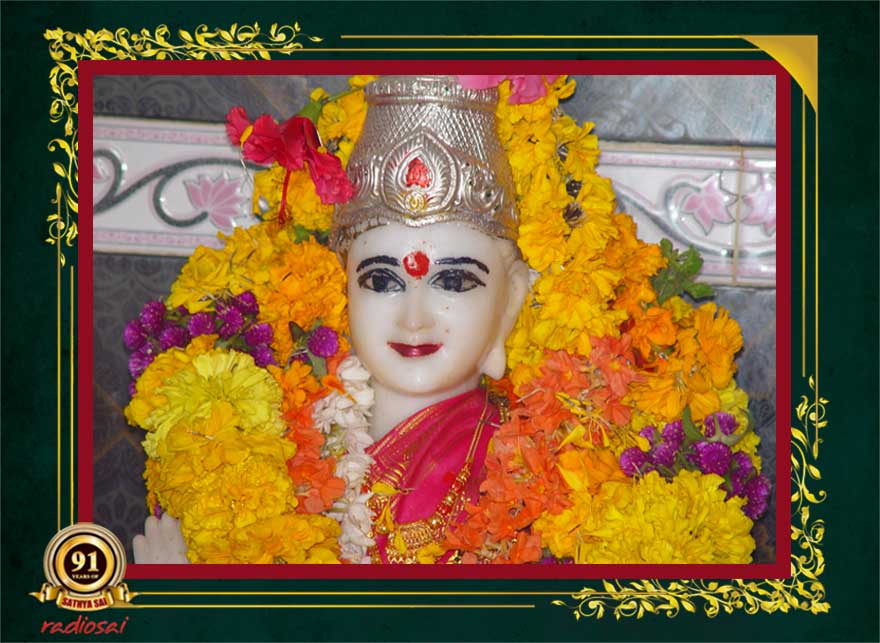|
|
| 'Like' us on Facebook | Follow us: |
Posted on: Nov 29, 2016
The Story of Sai - 4
And the lessons for you and me
Part 1 || Part 2 || Part 3 || Part 05 || Part 06 || Part 07 || Part 08
 |
The antiquity of The Ramayana, The Mahabharata, and The Bhagavatha is unquestionable and indecipherable. Yet in India they are as fresh and alive in people's consciousness as the stories of their own families. Rama, Krishna, Radha, etc. are almost a part of their daily life and living. What makes these legendary tales contemporary in every age? Rama's paintings and sculptures or Krishna's images and carvings, poems on Rama's glory or discussions on Krishna's message, are as passionately done now as they happened in 3 AD or 13 AD or 1300 AD. What makes them defy time and be relevant to every society over ages? Is it the incredible heroics of Rama? Or the delightful and miraculous sport of Krishna? Or the awesome plot of these captivating poetic narrations? While all this is true, what makes these epics eternal is something more fundamental.
 |
|
| 91st Birthday Celebrations Logo - Download |
“The Ramayana and the Mahabharata are like the heart and the head of India, and are as vital to India as the heart and the head are to a human body,” Bhagawan says and goes on to state what makes these epics so vital: “Sathya and dharma are not related to merely one person, one period of time, or one country; they are related to all people, all periods of time, and all countries...” It is because these tales are nothing but beautiful elaborations of Truth and Righteousness, that they have stood the test of time and circumstance. But this essence can be grasped only if these epics are read not as scintillating stories but as reinvigorating treatises on how to lead a life anchored to Truth and Righteousness.
As much as this is true for these ancient epics, it is the same with the current Sai Bhagavatha too. Every scene and character, sequence and incident, twist and turn in the Sai Saga is for the purpose of divinising man through the practice of Truth, Righteousness, Peace and Love. But to assimilate this deeply and internalise it intensely so that it can be translated into real action, the Story of Sai needs to be not just read but meditated upon assiduously. This series, started in November 2016, commemorating Bhagawan's 91st Birthday is an attempt in this direction. We hope this will help us to reflect more profoundly on the Sai Bhagavatha and implement the lessons learnt more powerfully in our day-to-day existence.
His Story
 |
|
| Bhagawan with His earthly grandfather Sri Kondama Raju |
In Puttaparthi there lived a devout, abstemious peasant named Kondama Raju of the Ratnakaram Raju family. The Raju family were Kshatriyas – the caste traditionally associated with the ruling class that administered law and order in society and protected its people during wars and invasions. However, the Raju family had long since abandoned its militant role and preferred engaging in interpreting and popularising sacred literature of ancient India, especially the epics - The Ramayana, The Mahabharata and The Bhagavata. Hence, they had the caste name Bhat Raju. The Bhats are generally associated with literature.
Reflection
In His writing, Sathya Sai Vahini, Baba explains that traditionally Indian society was grouped into four categories: Brahmin, Kshatriya, Vaisya and Shudra.
Among these, the Brahmins had the role of studying the scriptures and disseminating this knowledge to others while the Kshatriyas had the duty of protecting mankind from harm. Likewise, Vaishyas engaged in trade and business, while Shudras involved themselves in a host of activities, from farming to weaving, carpentry to pottery, and so on. Originally, this grouping of people was based on people’s innate nature and inclinations and not necessarily by birth. Thus, one could find someone born to Vaishya parents but interested in the learning and assimilation of sacred texts, thereby functioning like a Brahmin.
By way of example, Baba narrates the story of King Kaushika who was born as a Kshatriya but was deeply drawn to scriptures and intensely sought the vision of the Divine. This resulted in him transforming into Sage Vishwamitra who gifted mankind with the mother of all mantras, the Gayatri Mantra. Just as his name suggests, he became a friend and well-wisher of the entire world (vishwa + mitra).
We see a similar occurrence in the Ratnakaram Raju family. Though Sri Kondama Raju and his family members had Kshatriyas as their ancestors, they were interested in spending their energies and talent only in dwelling themselves in sacred literature and stories concerning the Divine. That is the reason why the title 'Bhat', generally used for Brahmins, got attached to them. Their attitudes and activities were more attuned to the Brahminic way of life.
His Story
Kondama Raju was blessed with great musical and dramatic talent. He beautifully sang songs from the Ramayana and when village plays were performed based on this epic, he loved to enact the role of Lakshmana. He was indeed greatly loved and revered by the village folk and was known for providing succour and solace to the distressed. Highly intelligent, he was also sought by the villagers for arbitration on disputes among them, such as those concerning land registration and the like.
Reflection
Thus, like true Brahmins, the Raju family dedicated their time and resources only to singing the glory of the Lord through melodious music, meaningful dramas and mesmerising poetry. It seemed as if they were more attuned to Brahman than those born as Brahmins! Perhaps this is one of the reasons why the Lord was attracted to be born into this household. For the Lord, what matters is our inner feelings not our birth or status or power. What is of value to Him is our internal intent, not what is patent outside.
Sri Kondama Raju, head of this family, had submitted himself totally to the service of the Lord –probably why he loved the character of Lakshmana. He suited this role perfectly. For Lakshmana, serving Rama was the breath of his life; he had no other dream or desire or goal for his existence. Kondama Raju too was such an exceptionally elevated soul, and could be yet another reason that prompted the same Lord Rama to choose this home to descend as Sai Rama. The remoteness of the location, the depravity of the family's economic position or the harshness of the living conditions in that setting was of no concern to the Lord because what draws Him to us is the richness of the soul that we cultivate not the riches of the earth that we accumulate.
His Story
One night the Goddess Sathyabhama, the consort of Lord Krishna, appeared in Kondama Raju's dream. She looked desolate, and was frantically looking out for her Lord whom she had sent to gather parijatha flowers. To add to her misery, there was a terrible rainstorm and she was unsheltered; she definitely needed help. Incidentally when the storm struck, Kondama Raju was passing by, and the Goddess asked him if he could provide her with shelter.
For Kondama Raju this was not a mere dream, it was real. When he woke up, the whole scene was fresh in his mind and the Divine Mother's request kept resounding within him. Then and there he decided that he would build a temple for Mother Sathyabhama. He did accomplish this without delay. Soon Sathyabhama became the deity for all the village folk.
 |
Reflection
While everyone goes to the Lord with some request or prayer or desire, to whom does the Lord go to with a wish to be fulfilled? If a mother wants a particular job to be accomplished, whom would she seek to get it done? Will she ask someone who comes to her every now and then looking for solace and succour or ask her own son and daughter to get it done?
The heart of Kondama Raju we saw was like that of Lakshmana. It is no surprise then that the same Mother who incarnated as Sita in Treta Yuga as the consort of Rama was now asking her Lakshmana to execute a task for her. She felt most comfortable asking Lakshmana to do it than anyone else because she knew that firstly, for Lakshmana, her words were as precious as Rama's orders and he would go to any extent to fulfil them. Secondly, he had the ability to carry them out too, thanks to Rama's ever-present grace on him. So, it was nobility and ability, earned by virtue of his purity, which had carved a special place for Lakshmana in Rama's heart. It was in all likelihood the same with Kondama Raju too. He also had become near and dear to the Lord, purely because of his intelligence, integrity and sincere devotion. That was perhaps why the Mother thought of him when she wanted a task to be carried out.
 |
| The shrine at Sathyamma Temple in Puttaparthi |
Baba says Lakshmana was gifted with sookshma buddhi, that is, sharp intelligence. Rama did not have to explicitly state the task or its modalities, Lakshmana understood all the subtle hints of Rama flawlessly. It was the same here too. Mother Sathyabhama did not have to overtly order Kondama Raju to build a temple, he understood the import of the dream unambiguously, with no doubts or questions. Thus a temple came up in no time. It was almost as if with the Lord descending in Puttaparthi, the Mother too wanted to be there to be part of the unfoldment of this divine saga. Kondama Raju was the instrument she chose for her descent.
Even today, in the Puttaparthi village, right next to the Venugopalaswamy temple stands the Sathyabhama (or Sathyamma as the villagers call her) temple. Just the darshan of the sparkling white statues of the Divine Mother here fill one with light, delight and sublimity. For every villager and visitor, it is a reminder that purity is all you need in order to become an instrument of the Lord.
Baba says if purity is present, God Himself will grant us the ability before He entrusts us with a responsibility. Everything that we encounter in our lives too has been given to us because we do have the ability to deal with it. If we depend on our limited talent and resources to resolve them we may face reversals but if we surrender to Him, we have access to His unlimited strength and resources, and nothing is impossible. What is more, we become a part of His story, just like Lakshmana and Kondama.
Part 1 || Part 2 || Part 3 || Part 05 || Part 06 || Part 07 || Part 08
− Bishu Prusty
Radio Sai Team
| comments powered by Disqus |






